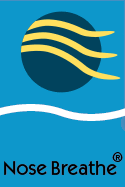
| Mouthpiece -
Patent No. #6,295,988 Oral Shield - Patent No. #6,295,988 Nose Breathe for Heavy Mouth Breather - Patent No. #6,053,168 Tongue Positioner/ Pacifier/Trainer Patent No. #6,412,489 Nose Breathe® Registered Trademark |

Traditional Chinese medicine saw the human body as a network of electrical circuits consisting of 12 meridians energizing our organ systems. Two of these meridians are known as the Master Meridians and in charged of the rest. They begin at the perineum: that part of body located between the genital and anus. The Conception meridian (Yin) runs in front of the body and ends at the tip of the tongue. The Governing meridian (Yang) runs along the back spine, top of the head, and ends at the area of the incisal papilla (little bump behind the two upper front teeth) on the hard palate. To keep the tongue at the roof of the mouth completes the “microcosmic circuit” and allows the energy to flow. This is important because balanced meridians contain the secret of energy and vitality. Keep the tongue at the roof of the mouth will keep one centered, relaxed, focused, in balance, and in the moment. Unless one is eating, drinking, talking, or in an impossible situation; the tongue should remain at the roof of the mouth. Words that express the flow of the harmonizing life energy:
Nasal breathing is the key to get the tongue to stay at the roof of the mouth.
|